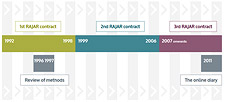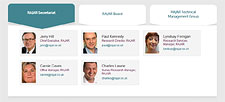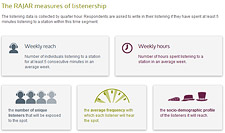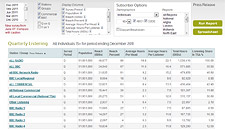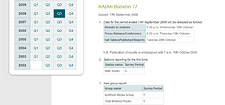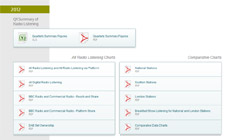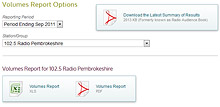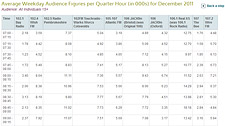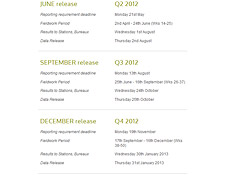Follow RAJAR's history since 1992 by hovering over the milestones.
1st RAJAR contract
The first RAJAR contract commenced with the measurement of radio audiences for Quarter 4, 1992 and was in operation up to and including Quarter 4, 1998. From Quarter 1 1999 the origins of current survey were put in place.
In common with the todays RAJAR service, this research carried out between 1992 and 1998 was based on a seven day self-completion diary, personally placed and collected by interviewers. Respondents completed their diaries using a list of relevant stations which were pre-printed across each diary page. Diaries were placed with all members of selected households.
The sampling and fieldwork plan for 1992-1998 permitted the publication of results for BBC and Commercial Radio national and regional services (with adult populations of 4 million or more) on a quarterly basis. Results for most local radio services, both Commercial and BBC, were published for each Quarter 2 and Quarter 4. Audiences for the smallest stations (with an adult population of under 300,000) were measured once a year, in Quarter 2.
2nd RAJAR contract
When planning the second RAJAR Contract from 1998 onwards, there was an obvious need to adjust the current system to an increasing complex radio market, in particular the growth in the number of Stations. A new Diary had to be design was required.
Other objectives for the new specification were to provide improvements in sample quality and reporting systems.
3rd RAJAR contract
Following a tender process, a new contract was awarded, starting in Q2 2007. Ipsos retained the fieldwork while sample design and weighting is handled by RSMB.
- Changes to the main contract include:
- A new diary featuring platform columns as well as location, allowing reporting on each platform separately.
- The move from postcode sectors to districts as building blocks to define TSAs, which led to a reduction in the number of segments, therefore bringing less volatility to the reported data.
The Current RAJAR Service
Due to the Covid pandemic the RAJAR service was halted at the end of Q1 2020 as face-to-face recruitment could no longer take place. The Q1 2020 Quarter was frozen as the last set of published data (over a 12-month period for all stations), with only trading updates being released internally each quarter since. As RAJAR had relied solely on face to face recruitment to place listening diaries with participants and with uncertainty on when this form of interviewing could return, various future related development work would be undertaken and assessed. During this time, the focus was to conduct and evaluate a suitable, robust, and compatible service that would remain resilient for the remainder of the pandemic and beyond.
Review of methods
In 1996 and 1997, RAJAR carried out a review of methods, followed by an extensive experimental programme of new diary and sample designs. Following this review, the new RAJAR contract specification included three key new features:
- A 'personalised' diary, customised to include the stations required by each individual respondent.
- Only one adult per household to be interviewed, instead of all household members.
- Measurement of audiences on a rolling basis, with listening data built up over three, six or twelve months, according to the size of the station, with publication of all stations results every quarter.
The online diary
From Quarter 3, 2011 RAJAR introduced an online version of radio listening diary (Radio Diary) as an additional collection methodology across all TSAs. It is recognised that respondent engagement is critical to the continued quality of the survey and that by offering a choice as to how people record and return their listening data will help maintain the current high levels of participation and completion into the future.
Additional benefits also include higher accuracy in attribution of listening to the different platforms (digital/non digital) as well as higher in home completion that in turn enhances overall data quality.
The mobile diary app
From Quarter 1, 2016 RAJAR Participants in the survey will now have the extended choice of recording their data via a mobile device as well as desktop or laptop and the traditional offline method. More than half of the 100,000 annual responses are now completed online. The diary app method was implemented into the sample in London in Q1 2016 and rolled out nationally by Q3 2016.
Review of methods
RAJAR return to service Q3 2021 on October 28th 2021. The methodology has partly been modified, whilst face to face recruitment remains it returns less sample than before and the currency has been supplemented with a radio listening panel; which uses both passive and active methods of data collection. Although some changes have occurred, the service has been designed around the traditional quarter-hour diary, therefore the data is reported and formatted the same way as before, however, RAJAR is advising that caution is exercised when making any comparisons with previous data.


